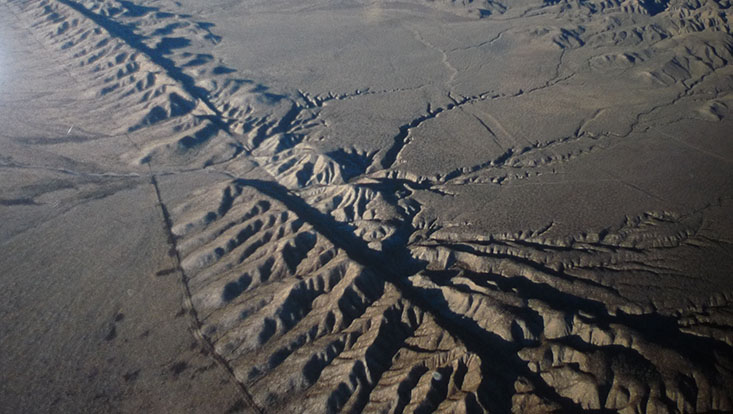Listening to the Gas Bubbles in the Earth’s Core
17 October 2018, by Stephanie Janssen

Photo: Dieter Schütz/pixelio.de
Dirk Gajewski has painted a clearer picture of the Earth’s interior, and would support further research into underground CO2 storage. The geophysicist and member of the CEN Board has recently been honored for his work – and will soon be making a tour of Europe.
Mr. Gajewski, you’re a geophysicist. Which characteristic of stone do you like the most?
Granite.
Is that a characteristic?
It is for me – I’m also a climber, and granite is my favorite type of stone. It’s crystalline and has a very coarse surface. With granite, balance is more important than upper body strength, which is great news for me! Chalk, on the other hand, like you can find in the Dolomites, is more compact and steeper.
But you’re a geophysicist, not a geologist. What type of research do you do?
Basically, it’s remote sensing, but without the satellites that are normally used. Instead we send acoustic waves into the Earth’s interior and catch the echoes. To do so, we place sensors, which are essentially our “ears,” on the Earth’s surface, in boreholes or on the seabed and listen to the sounds from the Earth’s interior.

What do you hear?
There are very loud natural noises when tectonic plates shift, setting off earthquakes. But we can also hear softer sounds like the underground lava and water flows, or gas bubbles rising through cracks. This allows us to monitor whether there are leaks at pumping sites for natural gas.
In addition, we can send out waves, which the various types of underground stone reflect in very different ways. We receive telltale signals, particularly where there are transitions to new rock layers. This means we can create a three-dimensional picture of the Earth’s interior, bit by bit.
.
You have now succeeded in making this picture even clearer. How did you manage this, since you could only take measurements at the surface?
I especially focus on diffractions. In terms of assessing the reflected echoes, until now there has always been a large percentage of signals that we were unable to use – like the so-called diffractions. They form in corners and at edges inside the rock, or in embedded glacial erratics. We position a very large number of sensors, and do so very precisely, which allows us to include the signals in the analysis for the first time.
Your new, more detailed picture deviates from the actual conditions by no more than one percent. That means, if I drill down 4,000 meters, the deviation is 40 meters at most. Why is that important?
This improvement makes a huge difference, since deep drilling is an extremely complex and costly undertaking. If you drill down several kilometers and don’t find the desired structures or raw materials, you have to start all over again. With the more detailed image I can search for potential storage sites for excess carbon dioxide, or CO2, and check their suitability.
Is this about sequestration, also known as carbon capture and storage or CCS? This is a technique used, for example, to prevent CO2 from coal-fired power stations from being released into the atmosphere, and instead storing it underground.
Yea, that as well. Currently, especially oil and natural gas storage sites are monitored using seismic methods. This allows mining companies to check whether everything is running as it should, and also how much oil and gas are still available. With a clearer picture of the Earth’s interior, we could also better monitor CO2 storage sites.
The German Federal Government’s 2012 draft law allows the individual states to prohibit CCS on their territory. There is substantial public opposition, and no state is actively pursuing CCS. Can the technology be controlled?
I think so. However, I see CCS as a provisional technology that can help us win some time, and not as a long-term solution to the carbon dioxide problem. But if we want to limit the global temperature rise to 1.5 or 2 degrees Celsius, we need to reduce CO2 quickly. That’s why I feel it would be a mistake not to explore CCS in detail.
Do you think that this opposition is irrational?
People often expect technologies to be 100 percent safe. But with complex technologies, you always have to weigh certain risks. That’s a very interesting aspect, since in real life we all do this quite frequently: we drive our cars on the highway, or go on plane flights. And I personally go mountain climbing. None of these things is 100 percent safe – and nevertheless we decide to go out and do them.
You were recently dubbed a “European Lecturer” by the Society of Exploration Geophysicists (SEG), an international society for applied geophysics. What will that mean for you?
Next year I’ll be touring throughout Europe, and will have the chance to present my research in more than 20 major cities – which is a great honor, but will also entail a great deal of work.
What do you plan to do next?
I’m a member of the CEN Board, and the interdisciplinary nature of the CEN is a wonderful aspect. In this regard, I’d like to further intensify the collaboration between the business, cultural and social sciences. Further, we are currently focusing on the topic of “machine learning” across disciplinary borders. If we stay on the ball, we could be at the forefront of this emerging, dynamic field.
Contact:
Prof. Dr. Dirk Gajewski

